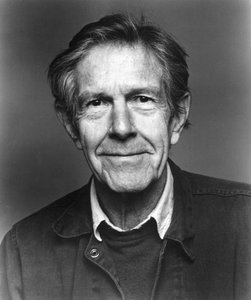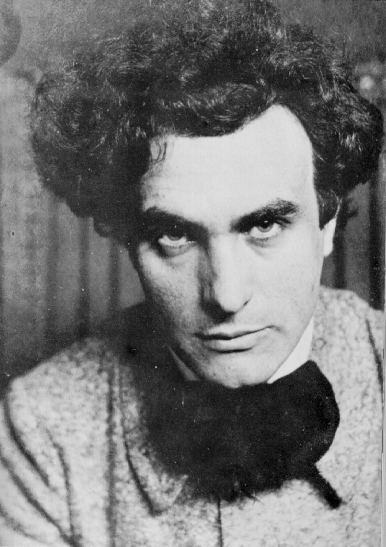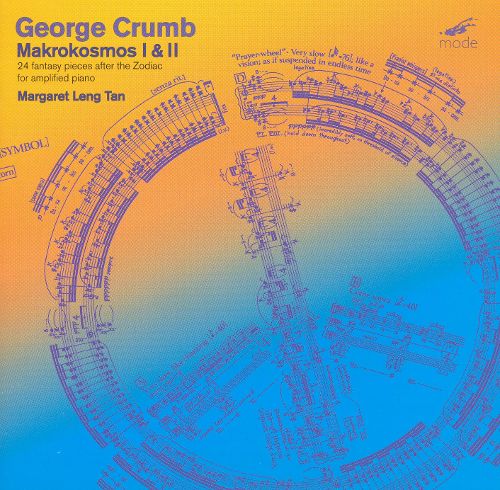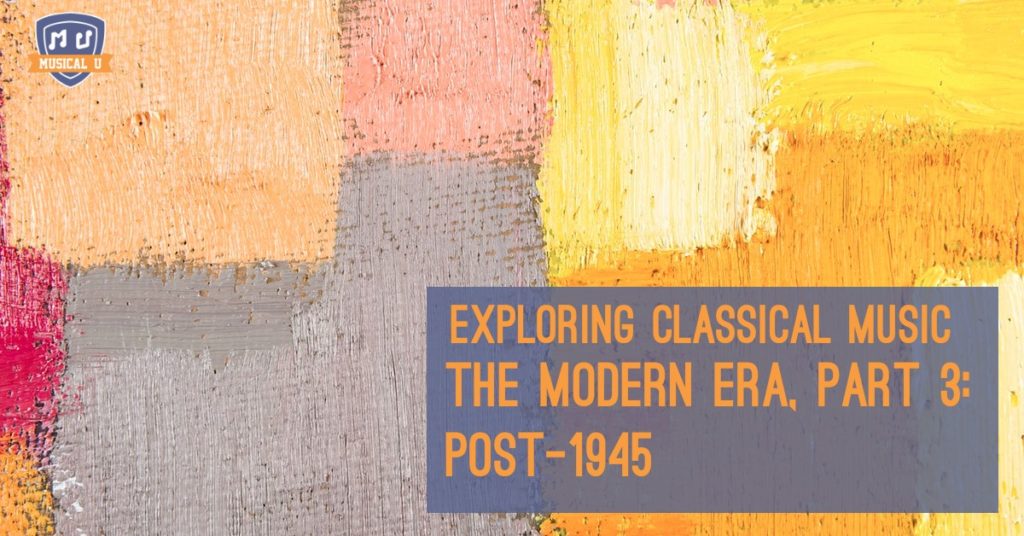In Exploring Classical Music: The Modern Era, Part 1 and Part 2, we explored modernist masterpieces of the early-to-mid 20th century, taking a look at how composers incorporated atonality, rhythm, impressionism, and eclecticism into their innovative masterpieces.
The mid-to-late 1900s proved an even more dynamic time for artists across the globe. Circumstances were shaped by unprecedented political change and a new world order (particularly post-1945), and along came a steady stream of fresh inspiration.
New frontiers opened by aviation, recording technology, and telecommunications channeled to artists stimulating ideas and materials from all over the world. Global intersections resulted, speaking volumes about an ever-shrinking world, where message and tone were refined to specific purposes, and composers worked to reconnect with disengaged audiences.
New Frontiers
Historians consider 1945 a turning point, when an obligation toward progressive processes and exploration of new technologies gained momentum. Each composer seemed to have his or her own story to tell, and most relevant compositional trends can be further explained by artists taking deliberate actions related to rejection, opposition, reinterpretation, and reinvention.
Elliott Carter (1908-2012) lived during and through World Wars I and II. Sergei Rachmaninoff (1873-1943) suffered the stranglehold of Communism, while others found fresh liberty via social reform associated with the feminist and Civil Rights movements; women like Ruth Crawford Seeger (1901-1953) took their rightful place in the fabric of American cultural life, and William Grant Still (1895-1978) boldly became the first black musician to conduct a major symphony orchestra.
The same technological advancements that made it possible to record and share music across the world inspired composers to merge pre-recorded sound with live performance, as well as to explore the manipulation of raw electronic noise into musical patterns and textures. Other composers sought to alter existing instruments, or to extend typical playing techniques to pioneer new sonic results. Debates raged about control versus freedom in regards to artistic elements and performer constraint. Still some artists seemed to crave a return to simplicity and accessibility, never surrendering fully to the past, but admitting finding motivation and guidance in it.
It’s impossible to assemble a collective of like-minded composers in this post-1945 era. Instead, let’s explore a selection of available platforms and threads occupying composers, where individual practices and idiosyncratic results are more realistic.
It’s also difficult to broadly summarize a consolidated musical language via a checklist related to melody, rhythm, harmony, and form; the examples to come instead provide a survey of varying inquiries and experiments made through musical means, to include chance and indeterminacy; electronic music and mixed media; and, extended techniques. In this light, we will consider where composers sourced sonic materials, and what relevant precedent and influence affected how they worked with those elements.
John Cage: A Pioneer of Indeterminacy in Music

John Cage, by WikiArt.org
John Cage (1912-1992) wanted listeners to re-think the long-standing definition of music as organized sound—unambiguous with definite melodic, rhythmic, and harmonic components. After rudimentary training (with Arnold Schoenberg, no less), Cage set about a series of experiments to assert his revolutionary notions about music and performance.
He explored extended techniques on piano and re-imagined ambient sounds as musical, forever altering the course of musical composition. While the general public easily dismissed Cage (or never really knew much about him at all), composers and academics couldn’t remain ambivalent. They acknowledged Cage’s experimentation, deeming it valid enough to face head on, process, and then judge, either advancing through or past his mid-century theories.
The Manipulated (“Prepared”) Piano
One of Cage’s monumental achievements is his set of Sonatas and Interludes (1948) for prepared piano. Included are 16 sonatas (in standard binary form and ternary form), plus four episodic, free interludes. As a comprehensive venture into prepared piano, the piece is legendary.
Basically, Cage manipulated the instrument from the inside, placing objects like screws and erasers in between strings to alter the sonic outcome. Not all of the strings are altered: he specifically targeted the higher register, so when the piece calls for notes from the piano’s lower range, the piano still sounds “normal.”
Spend a few minutes watching Stephen Drury’s video about how to prepare a piano, which surveys how the instrument must be manipulated before one can play the piece:
Music for the Prepared Piano
John Cage’s Sonata No. 1 for the prepared piano plays out as an AABB structure (where the A and B sections repeat). The piece opens 10 seconds into this video performance and lasts only about 2:20—compact, but packing a lot of punch.
The piece toggles between bold punctuated chords right in the mid-range of the keyboard at [0:08] and a distinct descending melodic motive [0:19-0:22]. These ideas are countered with a passage of hollow, percussive sounds at [0:26-0:32]. This opening A section closes out with an almost melancholy—and definitely more linear and melodic—passage from [0:33-0:52].
At [0:53], the pianist honors the repeat signs so expect a return to the opening material. This stand-by form, borrowed from sonatas of the past, breeds familiarity; in fact, Cage likely assumed a listener would appreciate the chance to engage in and process the radical musical content one more time.
At [1:34] comes the contrasting B section. Notably, this section shares some ideas with the A material (like the punctuated chords), so there is unity and a sort of prevailing organicism, meaning that one idea grows out of another. A fuller texture prevails in the more homophonic, almost choral sounds from [1:53-2:01] and at [2:07], the tinkling melodic passage sounds almost like electronically produced sound, another area of experimentation in which Cage was interested.
Rethinking “Music”
In a way, this second Cage piece featured here speaks for itself… or does it? In the 1950s, Cage boldly posed a number of challenges to other composers, performers, and even to listeners.
He asked, “What is music?”
He wondered if music had to match a pre-conceived notion about melodic sounds matched with harmonic devices, moved by some regular metrical pulse and realized by conventional, well-defined instruments. Cage suggested that music could instead be everywhere—existing and evolving in the environment and in the ever-changing soundscape of everyday life.
Cage even gave the performer some amount of freedom in deciding how musical components would be organized (letting them mix up the multiple pages of a score, for example, to play the sections in any random order). He went further to ponder if one could hear music in silence.
Silence and Noise
With all of that in mind, tackle Cage’s 1952 masterpiece 4’33”. Note the role of indeterminacy, where the artist relinquished control over the musical results and ensured that no performance of this piece would ever match the next.
Edgard Varèse: Music as Organized Sound
Edgard Varèse was a Frenchman whose artistic production happened mostly in the United States. He was a visionary, never satisfied with the conventional and always seeking a new portal to explore—and to challenge performers and listeners.
Even though Varèse famously declared in 1952 that he was “only interested in recorded music” (like many others he was into the absolute control that the medium offered), he was open to combining conventional orchestral instruments with the processes and sounds that modern technology was providing.
Live Orchestration with Electronic Tape
 Varèse’s “Déserts” calls for 15 live performers on brass, percussion, winds, and piano (no strings– Varèse wasn’t into them) to play along with a pre-recorded, two-track tape (previously produced by Varèse in Pierre Schaeffer’s famous Paris studio). The piece is built across four acoustic instrumental “Episodes” which toggle against three inserted tape “Interpolations.” It premiered in 1954 but wasn’t met with hearty applause from the Parisian audience—maybe because of its perceived peculiarities at the time.
Varèse’s “Déserts” calls for 15 live performers on brass, percussion, winds, and piano (no strings– Varèse wasn’t into them) to play along with a pre-recorded, two-track tape (previously produced by Varèse in Pierre Schaeffer’s famous Paris studio). The piece is built across four acoustic instrumental “Episodes” which toggle against three inserted tape “Interpolations.” It premiered in 1954 but wasn’t met with hearty applause from the Parisian audience—maybe because of its perceived peculiarities at the time.
There is no trace of a main melody, and beyond it being obviously athematic, the pitch content has no “home”—it is atonal. On top of that, the listener is treated to no regular, discernible beat for toe-tapping.
Episode I presents a static effect, where disparate sound masses are juxtaposed against one another. In fact, the very structure of the piece (Episode 1/Interpolation I followed by Episode 2/Interpolation 2) represents juxtaposition, as performers play conventional instruments on stage (Episode), then the tape takes over (Interpolation) while the acoustic instruments sit silent.
Music Beyond Melody
With little defined melodic, harmonic, or metrical interest, Varèse calls on listeners to target how the instrumentalists attack each sound: think carefully about how intense one sustained pitch is versus an opposite, more mellow tone. Note, too, the duration of a sound, and how carefully Varèse manages dynamics across a phrase between the start of the sound and when that sound, like those of the flute or clarinet, gradually dies out.
Irregular chimes (first a pair, then single attacks from [0:01-0:08]) seem to announce and welcome winds into the texture: note here how the flute and clarinet basically match the chime’s pitch, so what are really distinct timbres bleed imperceptibly into one another. All of this is built over a murmuring brass foundation.
Listen carefully at [0:49] as the trombones initiate a melodic motive, but instead of developing it into a cohesive theme, it fades out by [0:58], replaced by a shimmering gong strike and muted clarinet utterances in dialogue with dry snare hits by [1:02]. Another brass fanfare seems to take shape at [1:10] but again dies away by [1:17], confirming Varèse’s insistence on stagnant versus dynamic musical events.
Atmospheric Music
While Varèse indeed associated the piece with desolate landscapes related to a desert (the music was initially associated with a film), he also leaned into a parallel urban soundscape; the sounds of city life, in fact, proved inspirational for many mid-century painters, writers, and composers.
It’s not too far-fetched to associate certain sounds of the electronic taped portion with such an existence, and this becomes relevant in the first Interpolation at [3:08]. Maybe you hear footsteps on a sidewalk at [3:12-3:15] or the screech of overhead streetcar lines at [3:29-3:32]. A pause at [3:39] gives way to what one might associate with a ship’s horn at [3:40], which sets in flight a scampering flock of birds almost simultaneously.
Later, space and silence ease the tension (or build more in) from [4:45-50], but soon enough squealing brakes (of car or trolley trains) assault the ears at [5:21], and then it seems like we’re all in on the revelry, complete with whistles and catcalls, of a sporting event from [5:36-5:50].
One of the most fascinating aspects of this Interpolation segment is that Varèse assembled the sounds for it—sequencing, splicing, and re-organizing the aural glimpses in a studio. This section, then, is representative of Varèse organizing sound rather than composing music.
George Crumb: Reimagining String Instruments
George Crumb (b. 1929) resembles many modern experimentalists in his unceasing quest for new sounds, and he often takes available instruments and conventional techniques past their norms—and arguably to their extremes.
Political Inspiration
His Black Angels: 13 Images from the Dark Land (1970) is best understood in the context of the Vietnam War, which caused sharp divides between communities and aroused in him an urge to speak about political strife through art. The piece was commissioned by University of Michigan, but Crumb more specifically admitted to reacting to this dark time in America’s 20th century, when as he put it, “there were terrifying things in the air [and] they found their way into Black Angels.”
Black Angels calls for amplifying the standard string quartet (Crumb calls it the “electric string quartet”), made up of two violins, viola, and cello. Crumb realized unique timbral combinations by melding these chordophones with gongs and crystal glasses (tuned by differing water levels); each of the four string players is assigned additional tasks (like the cellist playing gong or the first violin playing maracas), so Crumb also re-imagined what a string performance traditionally entails.
 The main divisions of the piece are structured around a vague sequence of events: Departure—Absence—Return. The emotional chronology, which Crumb further described as a “voyage of the soul,” travels a “fall from grace” in the five sections of Departure; “spiritual annihilation” in four parts to Absence; and “redemption” in four more parts of Return.
The main divisions of the piece are structured around a vague sequence of events: Departure—Absence—Return. The emotional chronology, which Crumb further described as a “voyage of the soul,” travels a “fall from grace” in the five sections of Departure; “spiritual annihilation” in four parts to Absence; and “redemption” in four more parts of Return.
The 13-movement composition opens with “Night of the Electric Insects” (you may recognize it, since it’s included in The Exorcist soundtrack). “Danse macabre” is the fifth section of Departure.
Sinister Strings
Crumb wanted to pull listeners out of their comfort zone: instead of lush and lyrical, the violins sound raw, percussive, and eerie (thanks to special bowing techniques or hitting the strings with a thimble). The maracas’ dry shake adds a percussive layer to the movement’s ever-shifting beat pattern at [0:11]; when it shows up again at [0:21], it’s paired with the well-known Dies irae chant, a medieval melody traditionally used in a mass for the dead.
Crumb appropriated the tune, as many composers have over the centuries, since it matched the mood and message of the piece. Listen for its 7-note contour, plucked on the cello, from [0:21-0:24], and note that the pattern repeats from [0:31-0:34]. The violin’s limited burst of lyricism here is interrupted by violent bowing that creates clashing dissonance at [0:38].
As much as Crumb is channeling darkness and evil in “Danse macabre,” the music doesn’t come across as particularly scary. Instead, he seems to be putting evil in its place, allowing a sort of satirical poke at the power of darkness.
At [0:49], as the brief movement comes to a close, the instrumentalists simply chant, under their breath, the numbers 1 through 7 in Hungarian (throughout, the performers speak in many languages, including German, Russian, Japanese, and Swahili). It should be noted that Crumb was fascinated by numerology, but that topic is really beyond the scope of this tutorial: suffice it to say that 7 represents good and 13 represents evil.
Speaking about the work in 2004, Crumb said he believes the piece is timeless, and while it’s unfortunate to find resonance in the music’s message, indeed the world continues to cycle in and out of times of conflict and horror. Perhaps in it we can see and sense something of ourselves and our capacity to recognize and overpower dark forces.
Avant-Garde Sounds
Classical music post-1945 saw composers reimagining the very idea of music, often using instruments in new, unconventional ways, and blurring the line between music and sound. Countless approaches to this innovation were seen, from Cage’s use of musical “silence” to allow for ambient noise, to Varèse’s atonal use of conventionally melodic instruments.
This departure from tradition gets listeners to think about the interactions of sound with each other, and with silence. With melody taking a backseat, the listener is free to open their ears to elements such as duration of sounds, repetition, timbre, and the ways in which different sounds interact with one another.
Take a cue from these innovative composers by playing around with timbre, atmosphere, and rhythmic structures, or by changing the way you play your instrument! If inserting screws into your piano à la John Cage isn’t your cup of tea, try playing bowed guitar, use space and silence to build tension in your music, and experiment with playing your melodic instrument in a percussive manner. There are infinite ways to use a single instrument; play around with ways that you can draw some new, unusual sounds out of yours!







